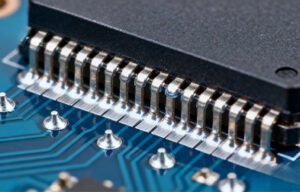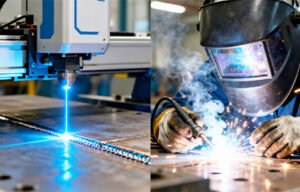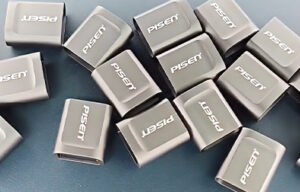How to Choose the Right Laser Welding Machine for Different Metal Thicknesses
Introduction
Selecting the correct laser welding machine for your metal thickness is crucial for achieving optimal welding results. Whether you work with ultra-thin stainless steel sheets or thick aluminum plates, the wrong laser setup can lead to under-penetration, overheating, or structural failure. This guide walks you through how to select the right laser welding solution based on the thickness and type of metal, helping you boost quality, productivity, and return on investment.
Why Metal Thickness Matters in Laser Welding
Metal thickness directly impacts heat absorption, penetration depth, and weld quality. Thin materials (e.g., under 1mm) are prone to warping or burn-through if the laser is too powerful. Conversely, thick materials (e.g., 5mm or more) require deeper penetration and greater power to ensure full fusion.
Welding performance is not just about power. The beam quality, spot size, and processing speed must be tailored to the material’s thickness to ensure consistent and reliable welds.
Common Laser Welding Technologies and Their Characteristics
There are several types of laser welding technologies available, including:
Fiber Laser Welding Machines: Excellent for a wide range of thicknesses, especially thin and reflective metals.
CO2 Laser Welding Machines: Suitable for non-metallics and some metal applications, but less efficient for thick metal.
Nd:YAG Laser Welding Machines: Good for pulsed applications but less common due to lower efficiency and maintenance costs.
MOPA Fiber Lasers: Adjustable pulse width makes them ideal for precision welding of thin and sensitive materials.
Understanding the advantages of each technology helps you choose a system that performs well across your material range.
Recommended Laser Welding Machines for Thin Metal Sheets
For materials below 2mm in thickness, precision is key. The ideal machine should have:
Low to Medium Power Output (200W–1000W)
High Beam Quality and Focus Control
Fast Scanning Capabilities (Galvo head optional)
Recommended Machines:
Handheld fiber laser welding machines (with low-power fiber source)
MOPA Galvo laser welding machines (for precision work)
Jewelry laser welding machines (for ultra-fine welds below 1mm)
Common applications include stainless steel kitchenware, lithium battery shells, and thin aluminum housings.
Best Laser Welding Solutions for Thick Metal Plates
For materials above 3mm, especially structural components or automotive parts, the laser needs high energy and deep penetration.
Recommended Machines:
High-power fiber laser welding systems (1.5kW–3kW)
Platform fiber laser welding machines with automation
Robotic laser welding systems (for volume production)
These machines offer greater thermal control, stable weld beads, and are suitable for carbon steel, aluminum alloys, and stainless steel.
Key Factors to Consider When Matching Machine to Thickness
Laser Power:
Thin materials require less power to prevent deformation. Thicker materials need more power to achieve full penetration.Focus Spot Size:
A smaller spot size allows for detailed welding on thin parts, while a larger spot delivers energy efficiently on thicker sections.Welding Speed:
Incorrect speed leads to weak or porous welds. The optimal speed varies with both material type and thickness.Cooling System:
Heat control is critical. For thicker materials, water cooling systems are preferable.Pulse vs. Continuous Mode:
Pulsed welding is often used for thin materials. Continuous wave (CW) is more suitable for thick plates.
Material Type and Joint Design Considerations
Even with the same thickness, different materials behave differently under laser welding:
Stainless Steel: Excellent absorption; suitable for most laser types.
Aluminum: High reflectivity; requires high-power fiber lasers and proper surface preparation.
Brass and Copper: Challenging due to reflectivity and thermal conductivity; often require MOPA or pulsed lasers.
In addition, the joint design (lap joint, butt joint, T-joint) can affect laser access and energy distribution.
Case Studies: Laser Welding Applications by Thickness
Case 1: 0.5mm Stainless Steel Enclosures
Used a 300W MOPA fiber laser with a Galvo head for high-speed seam welding. Achieved zero deformation with excellent aesthetics.
Case 2: 6mm Carbon Steel Frame Welding
Applied a 2000W platform fiber laser with automatic clamping. Weld depth was uniform with strong bonding.
Case 3: 2mm Aluminum Kitchen Equipment
Deployed a handheld 1500W fiber laser with wobble head for better gap tolerance and reduced heat marks.
Mistakes to Avoid When Choosing a Laser Welding Machine
Overpowering thin materials: Leads to burn-through and cosmetic damage.
Underpowering thick metals: Causes weak welds and lack of fusion.
Ignoring material reflectivity: Especially dangerous with aluminum and copper.
Choosing the wrong cooling system: Can result in overheating or instability.
Neglecting joint access and fixturing needs: Impacts consistency and usability.
Avoiding these pitfalls will help protect your investment and ensure efficient production.
Conclusion: Match the Right Machine to Your Metal Needs
Choosing the correct laser welding machine for your application goes beyond just power rating. Understanding your metal’s thickness, composition, joint type, and production volume ensures you pick a solution that delivers precision, durability, and cost-efficiency.
Whether you’re a small workshop handling delicate assemblies or a large manufacturer processing thick structural parts, JOYLASER offers a full range of laser welding solutions tailored to every need.
111-1024x458.png)


